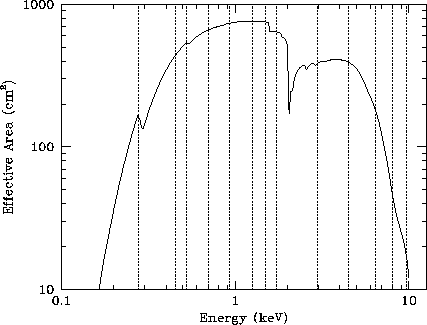
Next: 4.4 ACIS XRCF Measurement Up: 4 Calibration/Maintenance Previous: 4.2 Optical Blocking Filter
![]()
![]()
![]()
![]()

Next: 4.4 ACIS XRCF Measurement
Up: 4 Calibration/Maintenance
Previous: 4.2 Optical Blocking Filter
In the XRCF, an ACIS/HRMA calibration was done by collecting data to compare to performance models. This will be followed by study to improve those models by changing the model parameters to best agree with the measured data. The comparison must be carried out as a function of the HRMA/ACIS geometric configuration, incident photon angle and energy, and detector temperature. Measurements did not fill parameter space, but made the best effort to span it in a minimum total integration time. Each quantity was not directly measured at every possible value within the range of every other parameter, but enough were done to scientifically characterize the detector system.
The original calibration plan could not be carried out in its entirety, due to unavoidable delays in the schedule of delivery of the flight instrument to calibration. In order to avoid wasting the calibration facility time, a proxy ACIS instrument was developed by the MIT ACIS team, which consisted of a lab CCD camera electronics and dewar and two CCD chips of the same design as used in the flight chips. This instrument, called the ACIS-2C camera, was used at the XRCF in conjunction with the HRMA to make measurements relating to the single chip relation to the HRMA response. Toward the end of the calibration period, the flight ACIS instrument arrived at XRCF, and data relating especially to the flight chip layout and the gratings dispersed spectra were collected. (Note a third calibration effort was contemplated, but never used due to the arrival of the flight ACIS. An array of non-flight quality chips was prepared (called the XRCF paddle), to enable use of the flight electronics with a CCD array in case the flight paddle was not ready. In the event the flight paddle was actually used at XRCF.)
ACIS data collection at XRCF divided into four intervals, named by the XRCF Phase notation. ACIS-2C was inserted into the XRCF chamber at the start of Phase F. During Phase F the ACIS-2C collected data for 16.86 days, resulting in 10.0 days of data requested by the ACIS team, 5.4 days for the gratings teams, and 1.1 days of problem solving when no useful data resulted. Data collection lasted from 22 Feb 1997 to 10 Mar 1997. When the flight HRC instrument arrived at calibration, it was introduced into the XRCF tank with the ACIS-2C for Phase G. The HRC received priority on testing, and no ACIS-2C measurements were made until the HRC test program was completed. When the HRC program completed, additional ACIS-2C data were collected during Phase G from 10 April to 12 April 1997.
When the flight ACIS instrument arrived, Phase G was terminated and the HRC and ACIS-2C were removed from the XRCF tank. Phase H testing of the flight ACIS provided 8.25 days of test time, divided with 5.2 days for ACIS tests, 2.9 days for gratings and 0.15 days for problem solving. The Phase H testing lasted from 18 April to 26 April 1997, when the HRMA schedule demanded termination to allow the mirrors to leave for spacecraft integration.
Following the departure of the HRMA, additional testing using the XRCF sources, without the mirror, but with the flight ACIS instrument, continued at XRCF. These tests were called flat-field tests as they used the XRCF sources to fill the active CCD pixels with roughly uniform illumination. This phase, I, lasted from 8 May to 17 May 1997.
The specific types tests, which were not mutually exclusive but have different emphases, were:
The XRCF testing was arranged into types of test and each test was assigned a unique identifier based on a system suggested by TRW. These identifiers are known as TRW IDs. We present the list of measurements made at XRCF in thematic blocks. This structure corresponds to the basic philosophy behind the ACIS XRCF calibration. Because we cannot directly measure all possible observing situations (and because we will need to correct the XRCF results to zero-gravity and infinite source distance) the actual calibration results are models which acceptably reproduce the XRCF results collected during calibration. Because XRCF time was so critically short, we tried to be as efficient as possible in testing the models.
Hence the strategy was to explore the response of the instrument/HRMA to variation of single parameters, concentrating largely on the values expected during flight. In every way possible, we wish to minimize uncontrolled variation, and hence we choose to group measurements into blocks, which should be executed in a systematic manner, minimizing the chance of unforeseen variations in the other parameters or behavior of the instrument or facility.
 |

John Nousek